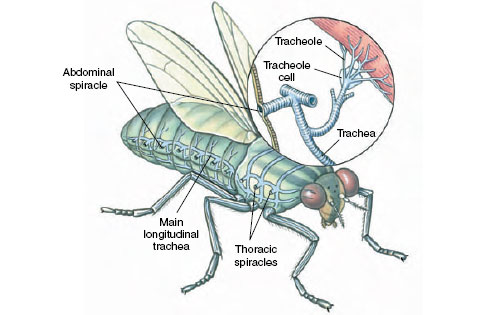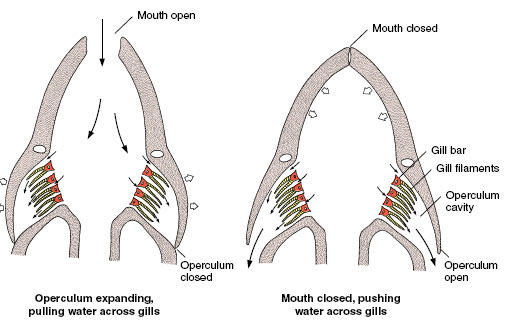Gas Exchange Through Tubes: Tracheal Systems
Gas Exchange Through Tubes:
Tracheal Systems
Insects and certain other terrestrial arthropods (centipedes, millipedes, and some spiders) have a highly specialized type of respiratory system, in many respects the simplest, most direct, and most efficient respiratory system found in active animals. It consists of a branching system of tubes (tracheae) that extends to all parts of the body (Figure 33-19). The smallest end channels are fluid-filled tracheoles, less than 1 µm in diameter, that sink into the plasma membranes of body cells. Air enters the tracheal system through valvelike openings (spiracles). Carbon dioxide diffuses out through spiracles. Some insects can ventilate the tracheal system with body movements; the familiar telescoping movement of the bee abdomen is an example. Because the cells have a direct pipeline to the outside, bringing oxygen in and carrying carbon dioxide out, an insect’s respiration is independent of its circulatory system. Consequently, insect blood plays no direct role in oxygen transport.
Efficient Exchange in Water: Gills
Gills of various types are effective respiratory devices for life in water. Gills may be simple external extensions of the body surface, such as dermal papulae of sea stars or branchial tufts of marine worms and aquatic amphibians . Most efficient are internal gills of fishes and arthropods. Fish gills are thin filamentous structures, richly supplied with blood vessels arranged so that blood flow is opposite to the flow of water across the gills. This arrangement, called countercurrent flow , provides the greatest possible extraction of oxygen from water. Water flows over the gills in a steady stream, pulled and pushed by an efficient, two-valved, branchial pump (Figure 33-20). Gill ventilation is often assisted by the fish’s forward movement through the water.
Insects and certain other terrestrial arthropods (centipedes, millipedes, and some spiders) have a highly specialized type of respiratory system, in many respects the simplest, most direct, and most efficient respiratory system found in active animals. It consists of a branching system of tubes (tracheae) that extends to all parts of the body (Figure 33-19). The smallest end channels are fluid-filled tracheoles, less than 1 µm in diameter, that sink into the plasma membranes of body cells. Air enters the tracheal system through valvelike openings (spiracles). Carbon dioxide diffuses out through spiracles. Some insects can ventilate the tracheal system with body movements; the familiar telescoping movement of the bee abdomen is an example. Because the cells have a direct pipeline to the outside, bringing oxygen in and carrying carbon dioxide out, an insect’s respiration is independent of its circulatory system. Consequently, insect blood plays no direct role in oxygen transport.
 |
| Figure 33-19 Tracheal system of insects. Air enters through spiracles, then travels through tracheae to reach tissues at tracheoles |
Efficient Exchange in Water: Gills
Gills of various types are effective respiratory devices for life in water. Gills may be simple external extensions of the body surface, such as dermal papulae of sea stars or branchial tufts of marine worms and aquatic amphibians . Most efficient are internal gills of fishes and arthropods. Fish gills are thin filamentous structures, richly supplied with blood vessels arranged so that blood flow is opposite to the flow of water across the gills. This arrangement, called countercurrent flow , provides the greatest possible extraction of oxygen from water. Water flows over the gills in a steady stream, pulled and pushed by an efficient, two-valved, branchial pump (Figure 33-20). Gill ventilation is often assisted by the fish’s forward movement through the water.
 |
| Figure 33-20 How a fish ventilates its gills. Through the action of two skeletal muscle pumps, one in the mouth cavity, the other in the opercular cavity, water is drawn into the mouth, passes over the gills, and exits through the gill covers (opercular clefts). |




